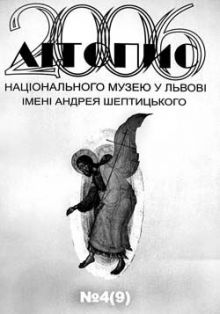From the very inception of the National Museum of Lviv, arguably one of the most important projects carried out by Metropolitan Andrei Sheptytsky, the hierarch of the Ukrainian Greek Catholic Church immediately raised the question of launching the museum’s publishing activity simultaneously with building a collection, and systematizing and studying it. Sheptytsky was very aware that it would be difficult to convey the museum’s exhibition and research activities to future generations of Ukrainians without a serious publication.
The idea for a museum yearbook was conceived much earlier, but the first issues appeared only in the 1930s with support from the Society of Friends of the Lviv National Museum. In 1934, during an annual meeting, “a society member, director Orest Radlovsky proposed” to earmark 600 zloty for the publication of a non-periodical publication called Chronicle of the Lviv National Museum. The first issue of the chronicle was soon published.
Oksana Bila, the museum’s deputy director, says that right after the chronicle was launched, its structure was clearly outlined. The museum’s then director, Ilarion Sventsytsky, gave a brief account of the main exhibition work held during the year and a review of the museum’s scholarly achievements. A column was planned to pay tribute to the museum staff members, who had devoted the greatest amount of effort to developing and establishing the museum. Also launched was a column featuring information about the museum’s financial earnings. The museum’s activity was thus public and transparent.
Four issues of the chronicle were published before the war. Then there was a long pause, and the publication was revived only in 2000. Today the museum employees are trying to continue the traditions established by the metropolitan and revive the columns that were originally published in the chronicle. These are brief accounts of exhibits, tributes to museum lovers who worked there for 20 or 30 years, a roundup of scholarly studies, and review articles devoted to artists whose works have been recently added to the museum’s collection.
So-called white pages of the museum’s history, prepared by famous Lviv art historians, including Mykhailo Batih, are now being published, sparking intense interest among readers. The chronicle is aimed at art historians, culturologists, research fellows, and everyone who is passionately interested in Ukrainian culture. The print run is small — only 1,000 copies — although owing to its content, the chronicle could easily target a larger audience. The latest issue features articles on the work of O. Kulchytska, I. Severyn, M. Hlushchenko, and P. Kholodny, illustrated Frankiana, and newly discovered masterpieces of icon painting.
However, not even this small number of copies could have been printed without a charitable contribution from Khrystyna Dybuliak-Chorpita, the owner of a private art gallery in Philadelphia, who funds the entire chronicle at her own expense. She not only contributes money, but also takes part in designing and laying out the chronicle. She is credited with implementing many other projects at the museum, including the publication of exhibit catalogs and several jubilee editions devoted to the centennial of Sviatoslav Hordynsky, Oleksa Novakivsky’s jubilee, and the centennial of the Lviv museum. Some of these publications always remain in the museum, while some are distributed to Ukrainian libraries. Ms. Dybuliak-Chorpita also takes a few publications to Philadelphia so that information about the National Museum of Lviv will reach a wider circle of readers.







